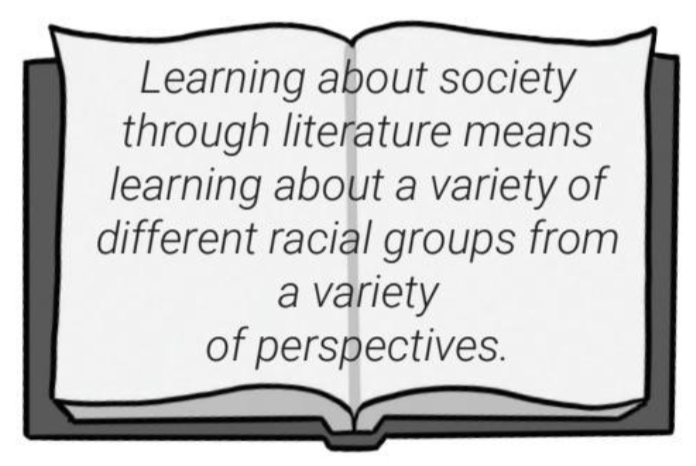Texts in humanities classes overplay white narrative
Though student schedules may vary considerably throughout high school, history and English are two courses that typical Gunn students take all four years. These classes rely heavily on novels, articles or textbooks. In fact, a primary learning target in these classes is interpreting and analyzing writing. Thus, the books used in these classes should include a variety of cultures to represent history accurately and faithfully, making sure to acknowledge oppression. However, a number of texts used in the history and English curricula include outdated and racist ideas and writings.
A prime example of this issue is in the textbook “World History” by William J. Duiker and Jackson J. Spielvogel, which is used in the yearlong World History course for freshmen and the semester-long Contemporary World History course for sophomores. The text covers events from prehistory to after the Cold War, including worldwide imperialism and colonial rule in Africa, India and Southeast Asia. On page 634 in the textbook, at the conclusion of the imperialism unit, Duiker and Spielvogel contend that “neither extreme position [of arguing for or against colonialism] is justified.” They argue that one can weigh the oppression and murder of millions against the “cross-cultural encounters” or “global economic development.” Such an argument grossly understates the vicious nature of imperialism and justifies the cruelty inflicted upon those in colonized countries. Granted, textbooks are meant to be objective and include a variety of perspectives. However, there is a difference between presenting motivations and justifying actions. There is no justification for killing or forcibly removing people from their homes. To add insult to injury, the passage cites a series of white men, neglecting to include the perspectives of prominent historians of color or even female historians.
This problem extends to the text for the AP U.S. History, in “The American Pageant, AP Edition” by David M. Kennedy and Lizabeth Cohen. Although the book has been updated over numerous editions, the text still contains a number of problematic passages, most notably about the treatment of Native Americans. On page 22, the book says that though “Spanish invaders did indeed kill, enslave and infect countless natives,” they also “grafted their culture, laws, religion and language onto a wide array of native societies, laying the foundations for a score of Spanish-speaking nations.” It then goes on to say that “[The] Spanish paid the Native Americans the high compliment of fusing with them through marriage and incorporating indigenous culture into their own.” Throughout the textbook, Kennedy and Cohen use the term “Indians” to refer to Native Americans, rather than “American Indians,” “Native Americans” or “indigenous peoples.” This is a single page of the book, yet it manages to mislabel an entire culture, say that the slaughter of said people was excusable for the pursuit of empire and imply that this group was lesser than the Spaniards. It’s easy to see why this text is appalling, especially considering how dependent AP U.S. History students are on textbook readings; “The American Pageant” is a staple of the curriculum.
The same issue holds with the English curriculum. The classics students read throughout high school are often revered for their vivid characterization or complex themes, though many are written by white authors and have racist elements in them. Take, for example, “To Kill a Mockingbird,” a foundational text about race in the Jim Crow South. While it has been taught for its good points for generations, it perpetuates the “white savior” narrative through one of its principal characters, Atticus Finch. Throughout the novel, he’s presented as “saving” the black man Tom Robinson, who has been wrongly convicted of raping a white woman. There are much more relevant books written by a diverse array of authors that discuss the same topics—Angie Thomas’s “The Hate U Give,” for one, or Bryan Stevenson’s “Just Mercy.” Learning about society through literature means learning about a variety of different racial groups from a variety of perspectives. How else is one to have a holistic view?
This isn’t to say that there hasn’t been progress. Both the English and history departments have taken steps to improve the situation. According to English Department Instructional Lead Paul Dunlap, teachers have been working to expand the pantheon of authors and place an emphasis on discussing issues about race in recent years. This has been especially true in the wake of the resurgence of the Black Lives Matter movement in 2020. Social Studies Department Instructional Lead Jeff Patrick noted that the history department also has conversations about the topics and curriculum at meetings, with the goal to approach racial issues in a way that promotes understanding of the motives behind actions without justifying the actions themselves. The Student Equity Committee at Gunn is involved in discussions about textbooks and curriculum as well. Flexibility in both departments makes supplementing the problematic textbooks and novels easier. Right now, the perspective for both history and English isn’t to remove, but to augment.
This augmentation, however, comes with its disadvantages. Giving teachers more freedom with which texts are used or how rigorously they are used could cause students’ experiences in history and English to vary considerably depending on what instructor they have. One teacher might choose to teach more texts with authors of color, while another might opt for less diverse books; one teacher could rely heavily on the World History textbook, while another might not. The lack of standardization, while beneficial in some respects, means that some students might go through their English courses with less exposure to writers and characters of color; in history, they might see their culture misrepresented.
So what’s the solution? It’s important to acknowledge that there is currently a nationwide discussion on this topic. While some are electing to remove texts that contain offensive material from libraries, others are banning teaching critical race theory. It’s necessary, then, to approach the matter carefully. This isn’t a call for all problematic textbooks to be thrown out the window. Rather, the goal is to bring attention to the issues that are present, in the hopes that students and teachers can spend more time discussing this inside and outside the classroom. Conversations and academic discourse foster greater curriculum changes and broad education. After all, the texts societies use and how they use them reflect their values and ideals as a whole. Haven’t people always said the pen is mightier than the sword?
Your donation will support the student journalists of Henry M. Gunn High School. Your contribution will allow us to purchase equipment and cover our annual website hosting costs.

Senior Amann Mahajan is the editor-in-chief of The Oracle and has been on staff since January 2022. When she’s not reporting, she enjoys solving crosswords,...





Lucy • Apr 2, 2022 at 6:08 am
*Is* Atticus Finch presented as “saving” Tom Robinson?
Most obviously, Tom ends up dead (so definitely not saved) — just as happened in the real-life cases upon which TKAM is loosely based. The most Atticus achieves for Tom is that he winds up shot rather than lynched.
But also, it’s clear in the book that, although he never entirely gives up hope, Atticus knows throughout (although his daughter Scout does not realise until late in the narrative) that there’s only ever at best a very slim chance of Tom’s survival, in spite of his obvious innocence, because of the way that the cards are stacked against him because of his race.
It is very definitely a story of growing up as a White person in the segregated South and it shouldn’t push Black voices from that era out of the curriculum. But I don’t see how it’s a White Savior narrative.